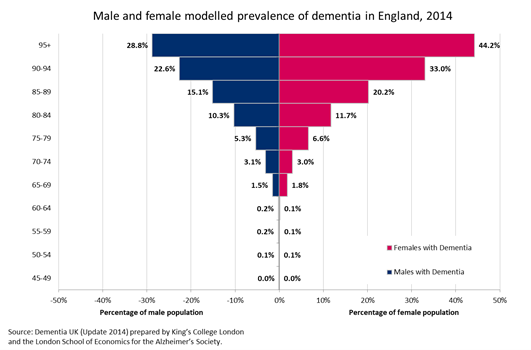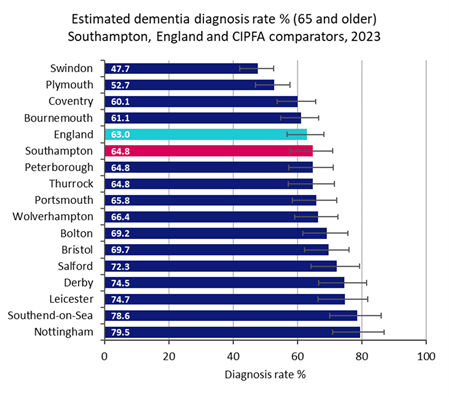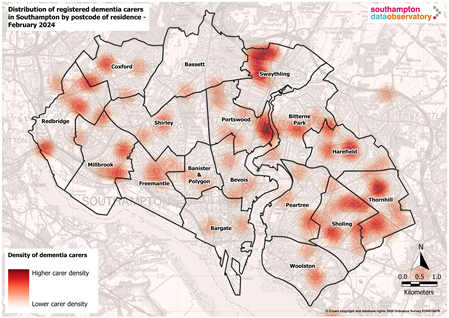
Dementia
 Dementia
Dementia
Dementia is a general term for a loss of memory, language, problem-solving or other thinking ability that is severe enough to interfere with daily life. There are different diseases that can be categorised as dementia with a variety of causes. Dementia is progressive, symptoms may be mild to begin with but get worse over time, having a substantial impact on a person’s life and the people around them. Dementia is also a life-limiting condition, it is the 6th biggest cause of death in England (GBD 2019). Alzheimer's is the most common form of dementia and accounts for more than half of England's dementia cases. It is estimated that more than 800,000 people are currently living with dementia in England. Dementia is significantly more prevalent amongst older people, around 98% of people with dementia in England are aged 65 or over. Due to England’s ageing population, where the 65 and over age group is growing year-on-year, dementia cases are projected to reach one million in England by 2035.
At around 80 years of age, some studies have found that dementia becomes more prevalent among females. This gap appears to grow wider as people get older, women aged 95 or older are 53% more likely to have dementia than men. This potentially higher female prevalence, along with the fact that women tend to live longer than men, means that women make up nearly two thirds of all dementia cases in England.
While under 65 year olds make up less than 2% of all dementia cases in England, this still equates to more than 15,000 people currently living with ‘early onset dementia' in England. Early onset dementia is slightly more prevalent amongst men than women, some of the risks and causes of early onset dementia like head injuries and alcohol-related brain damage (ARBD) are more common among men. The number of early onset dementia cases is not expected to change significantly in England for the foreseeable future, as this age group is expected to remain similar in size.
Research on dementia prevention is still ongoing, however there are certain risks that appear to influence an individual’s chance of getting dementia later in life. These include smoking, obesity and drinking more than 14 units of alcohol per week. There is no known cure for dementia, however early detection and the right care helps people to live as well as possible. There is evidence that dementia diagnoses and care planning reduced during the COVID-19 pandemic and are yet to recover to pre-pandemic levels. Dementia care is often informal and unpaid, provided by friends or family. Caring for a loved one with dementia can be challenging, the NHS provides useful information and further support for dementia carers. (NHS England - looking after someone with dementia).
Dementia prevalence and diagnosis
 In 2021, diagnosed dementia rates were found to be more prevalent in the east of Southampton. Most of Bassett and some neighbourhoods in Coxford, Shirley, Millbrook and the centre of the city also had rates above the Southampton average. These areas also have a higher proportion of over 65 year old residents than the city average. More information on Southampton's demographics can be found on our Census 2021 page.
In 2021, diagnosed dementia rates were found to be more prevalent in the east of Southampton. Most of Bassett and some neighbourhoods in Coxford, Shirley, Millbrook and the centre of the city also had rates above the Southampton average. These areas also have a higher proportion of over 65 year old residents than the city average. More information on Southampton's demographics can be found on our Census 2021 page.
In 2020, Southampton’s crude prevalence of dementia among under 65 year olds (2.2 per 10,000 population) was significantly lower than the England average (3.1 per 10,000) and was the second lowest rate among its CIPFA comparators. Southampton also has one of the lowest crude dementia rates of its CIPFA comparators for people aged 65 or over (4.0% in 2020). This may be explained by Southampton’s relatively young population, however it could also be influenced by disparities in how well dementia is diagnosed in different parts of the country.
To understand the true scale of dementia in a population, it is more useful to use modelled estimates rather than diagnosed cases as many people have dementia without a formal diagnosis. Dementia prevalence is surveyed in a sample population by age and sex, these prevalence rates are then applied to the population structure of a given area. In 2023 there were 1,726 people aged 65 or over in Southampton diagnosed with dementia, however the number of people living with dementia in the city was estimated to be significantly higher (2,663). This is expected to reach 4,480 by 2040.
 These estimates can also be used to calculate how well an area is diagnosing dementia. In 2023 it was estimated that Southampton diagnosed 64.8% of all dementia cases, statistically similar to the England average (63.0%) but below NHS England’s target of two thirds (66.7%). Southampton has the 5th lowest dementia diagnosis rate of its CIPFA comparators. While none of Southampton’s comparator cities have a significantly better rate, five of them are diagnosing more than 70% of their estimated dementia cases. Nottingham is close to achieving a dementia diagnosis rate of 80%.
These estimates can also be used to calculate how well an area is diagnosing dementia. In 2023 it was estimated that Southampton diagnosed 64.8% of all dementia cases, statistically similar to the England average (63.0%) but below NHS England’s target of two thirds (66.7%). Southampton has the 5th lowest dementia diagnosis rate of its CIPFA comparators. While none of Southampton’s comparator cities have a significantly better rate, five of them are diagnosing more than 70% of their estimated dementia cases. Nottingham is close to achieving a dementia diagnosis rate of 80%.
The NHS and central government have committed to increasing dementia diagnosis rates, formal diagnoses can help dementia carers and healthcare professionals provide the best care possible. However, dementia diagnosis rates in 2023 were lower than they were in 2017 for Southampton and England. Southampton’s dementia diagnosis rate dropped by 5.5 percentage points in 2021 during the COVID-19 pandemic, potentially due to some people avoiding healthcare settings. While rates have increased in 2022 and 2023, they are yet to reach pre-pandemic levels. Increasing the percentage of dementia diagnoses in the future will be made more difficult by England’s ageing population structure, the number of new dementia cases to diagnose will increase each year.
Dementia care
Most people diagnosed with dementia continue living at home, particularly in the early stages. There are ways to make a home more dementia friendly, however almost all people with dementia will eventually need help from other people with day-to-day tasks. This may be from professional carers, friends or family. Living at home with dementia isn’t the right choice for everyone, it is estimated that 70% of people with dementia may eventually need long-term residential care. In 2020 it was calculated that Southampton had enough residential and nursing home bed capacity for 68.6% of registered dementia patients, below the target of 70% and significantly lower than the England average of 75.3%. Care planning is critical to ensuring dementia care is as effective as possible. Care plans must be personalised to each individual and need to be regularly reviewed to keep up with the patient’s changing needs. Dementia care plan reviews dropped significantly in the period 2020/21 during the COVID-19 pandemic. In Southampton just over one in every three dementia care plans were reviewed annually (33.6%), significantly lower than the England average of 39.7%.
Care planning is critical to ensuring dementia care is as effective as possible. Care plans must be personalised to each individual and need to be regularly reviewed to keep up with the patient’s changing needs. Dementia care plan reviews dropped significantly in the period 2020/21 during the COVID-19 pandemic. In Southampton just over one in every three dementia care plans were reviewed annually (33.6%), significantly lower than the England average of 39.7%.
As of February 2024, there are 110 registered dementia carers in Southampton known to the council. While they are spread across all Southampton localities, parts of the city with a younger average age or a lower deprivation score seem to have fewer dementia carers living there. Southampton’s least deprived neighbourhoods are in Bassett, where there are very few registered dementia carers (despite Bassett having some of Southampton’s highest dementia rates). Bargate has some of the youngest neighbourhoods in the city and also has a low number of registered carers living there.
 Dementia hospital admissions
Dementia hospital admissions
While Southampton has relatively low dementia prevalence rates, it has some of the highest rates of dementia related hospital admissions in the whole of England. For age standardised emergency admissions among people aged 65 and over Southampton has the 7th highest rate in England (5,507 per 100,000 people in 2019/20), this is 57% higher than the England average (3,517). Short stay emergency admissions are also significantly higher than the England average. While these rates are noteworthy, hospital admission statistics are easily skewed by different coding practices. An admission in Southampton may have a dementia code added to it where it wouldn’t in other parts of the country. We know from alcohol and obesity related admission statistics that Southampton hospitals use secondary coding to improve care pathways, however this makes comparisons less robust as Southampton looks exceptionally high.
Dementia related mortality
For age standardised mortality from dementia among people aged 65 and over, in 2019 Southampton had a lower rate (331 per 100,000 people) than the England average (849 per 100,000 people) however there is not a statistically significant difference. Southampton has the 7th lowest mortality rate of its CIPFA comparators and is statistically similar to all but one (Leicester has a significantly higher rate of 511 per 100,000).
Most people with dementia die in care homes, this accounted for 53.2% of all Southampton’s dementia related deaths in 2019. People dying with dementia in their usual place of residence is used as a proxy for preferred place of death. In 2019, 67.8% of people in Southampton died with dementia in their usual place of residence, statistically similar to the England average (70.3%). The other dementia related deaths were in hospitals, 107 people with dementia in Southampton died in a hospital in 2019.
Resources
OHID Fingertips – Dementia Profile
Data for a range of measures on dementia prevalence, preventing well, diagnosing well, living well, supporting well and dying well. Indicators are available for England, local authorities, ICB, sub ICB and historical health geographies.
NHS – Dementia Guide
This NHS guide has general information on dementia, symptoms and diagnosis, living with dementia and information on dementia care. It also has support and information for people living with dementia and their families and friends.
NHS England – Dementia
Information on NHS England’s dementia strategy, partnerships and resources for dementia care. There is also information on central government dementia related initiatives such as the Prime Minister launched his Challenge on Dementia 2020.
Dementia UK – Information and Support
Information on dementia from a specialist dementia nursing charity. Contains information and support for all dementia related issues. You can also contact dementia specialist nurses through Dementia UK if you have any further questions about dementia.
Alzheimer’s Society – About Dementia
Information on dementia from a specialist dementia charity. Contains information and support for all dementia related issues. You can also contact dementia specialist nurses through the Alzheimer’s UK if you have any further questions about dementia.
Census 2021 – Interactive Dashboard
A range of data insights from Census 2021, age related statistics will be particularly relevant to dementia. Users can access a range of Census data across different topic areas including population, education, identity, housing, health and work. With the ability to view benchmarking between Southampton and ONS comparators and mapping of data by Census geographies; such as lower layer super output areas (LSOA) a neighbourhood of around 1,500 residents.
Hampshire County Council (HCC) - Major conditions report
The major conditions report from Hampshire County Council includes information about prevalence, emergency admissions and deaths in seven major conditions: cancer, cardiovascular disease, respiratory disease, dementia, mental health, musculoskeletal conditions and chronic kidney disease.
Last updated: 05 March 2024